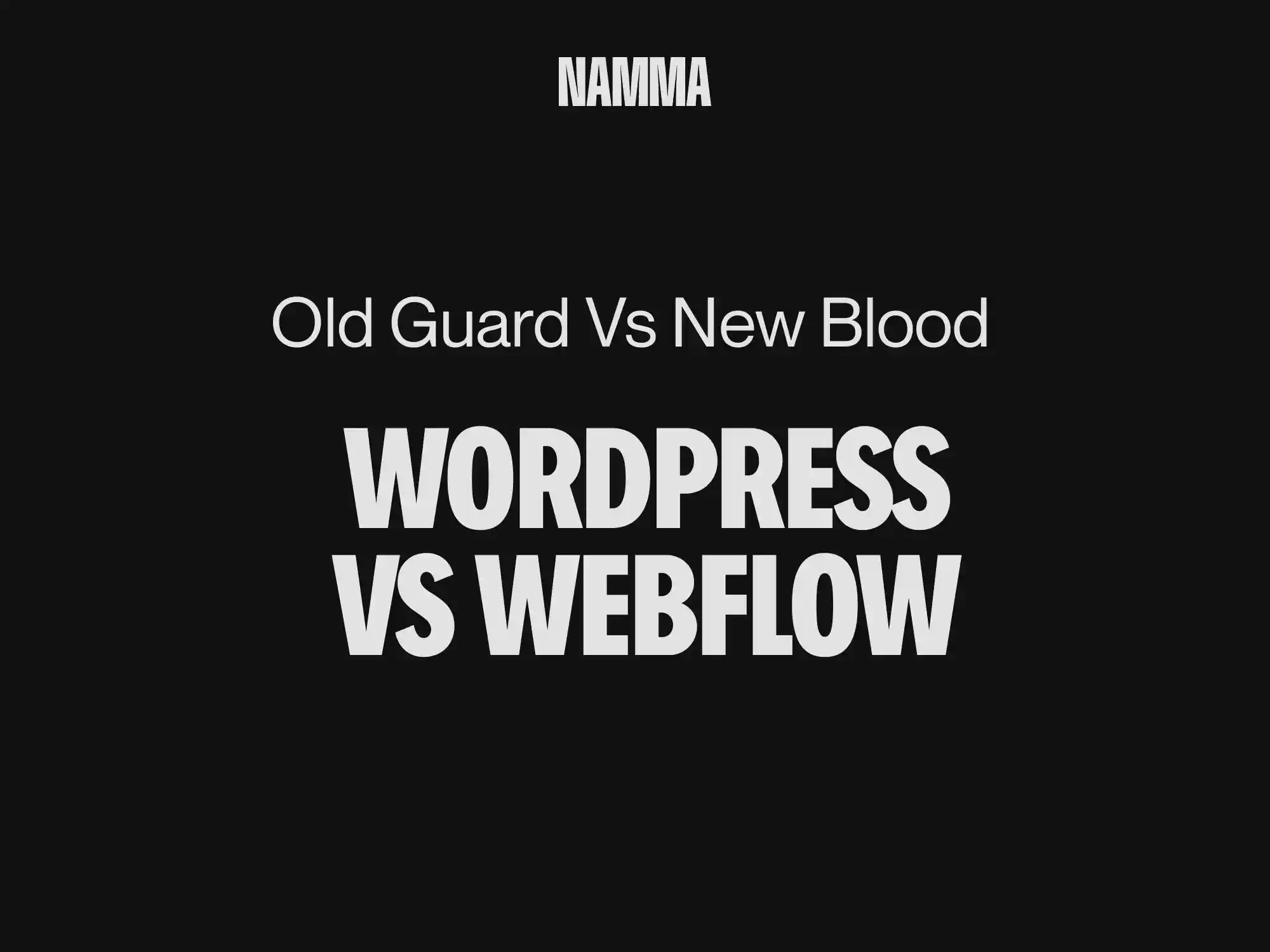Webflow : The Ultimate Guide in 2025
Stop limiting yourself with tools that stifle your creativity.
You know the situation. Those platforms that promise you’ll create a “professional” site in three clicks, then lock you into a rigid shell the moment you want to go off the beaten path. Where every attempt at customization hits a “this feature is only available in the premium plan.” Where your creative vision is reduced to what the platform is willing to let you do.
There is an alternative. And no, it’s not another limited visual builder where you’re doomed to create sites that look like everyone else’s—the clones you recognize at first glance.
Welcome to the world of Webflow, the tool that finally understands you deserve better than prefabricated blocks and generic templates.
What exactly is Webflow?
In simple terms? Webflow is a web creation platform that offers the power of code without requiring you to write it.
In concrete terms? It’s the perfect marriage of the flexibility of custom development and the accessibility of a visual builder.
But beware: Webflow is not “yet another site builder.” It’s a full web development platform that combines:
- A powerful visual editor that generates clean code
- A flexible content management system (CMS)
- Built‑in e‑commerce features
- Sophisticated animation and interaction capabilities
- Optimized, secure hosting
The fundamental difference? Webflow doesn’t lock you into rigid templates. You build exactly what you want, pixel by pixel, with total creative freedom—without sacrificing technical quality or maintainability.
[Want to compare Webflow to other platforms like WordPress, Shopify, or Wix? Check out our dedicated comparison article to make the best choice.]

Why Webflow changes the game (and not just a little)
Clean code, finally accessible to everyone
If you’ve ever used a visual builder, you know the problem: the generated code is often an indecipherable nightmare—an entangled mess of nested divs and generic classes that would drive any developer insane.
Webflow? It’s the exact opposite. The generated code is so clean that seasoned front‑end developers use it to prototype quickly.
"Webflow marks a historical turning point in how the web is built. For the first time, a visual tool produces code that developers respect."
Vlad Magdalin, co‑founder and CEO of Webflow
Concretely, that means:
- A faster site (crucial for SEO)
- Flawless browser compatibility
- A solid foundation for future evolution
- The ability to export your code if needed
A CMS that redefines content management
Webflow’s content management system is a revolution in itself.
Imagine a CMS where you can:
- Create custom content types in a few clicks
- Precisely define how they display on your site
- Establish complex relationships between different content types
- Dynamically filter and sort your content
All that, without extra plugins, without code, without hassle.
Want a blog? Easy.
A product catalog? Simple.
A complex documentation system with categories and tags? No problem.

[For an in‑depth analysis of the differences between Webflow’s CMS and other popular systems, check out our dedicated comparison.]
Responsive design that actually works
Building a site that adapts perfectly to all screens is often a nightmare. Too many platforms promise “responsive” design that turns disastrous once you leave standard dimensions.
Webflow approaches responsive design fundamentally differently:
- You control precisely how your site appears at each breakpoint
- You can hide, reorder, or transform elements according to screen size
- You visualize in real time how your site adapts
Result? A site that works flawlessly across devices, from smartphones to 4K screens.
Unlimited animations and interactions
Forget generic animations or basic interactions. With Webflow, you can create:
- Scroll‑triggered animations
- Page transitions
- Complex interactions based on user actions
- Sophisticated animation sequences
Without writing a single line of JavaScript. No third‑party plugins. Directly in the visual interface.
It’s like having an advanced prototyping tool and a production environment in the same platform.
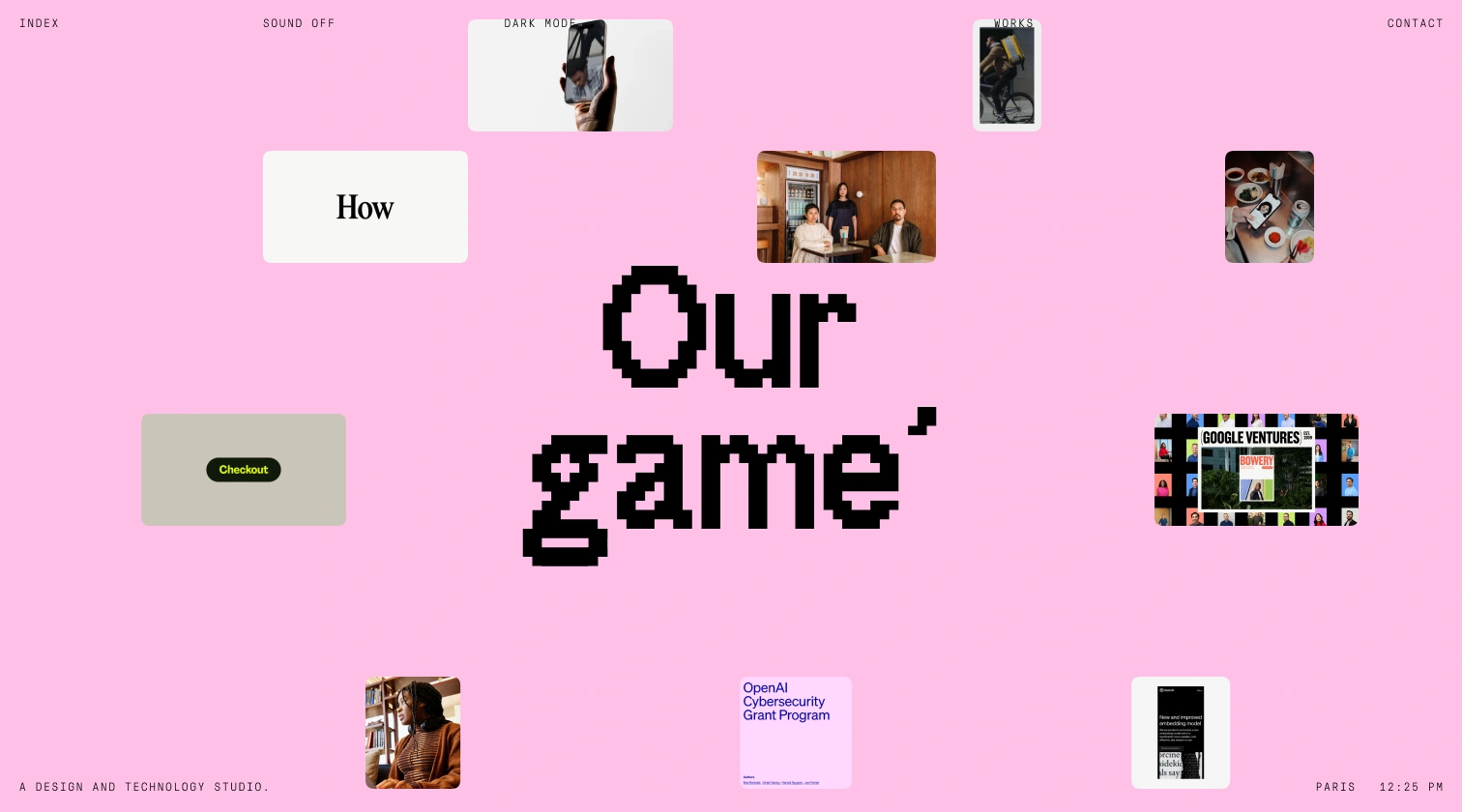
The anatomy of Webflow: key components
Understanding Webflow is like discovering the controls of a sports car after driving a basic hatchback. At first it can be intimidating. But once you master the basics, you’ll wonder how you ever settled for less.
The Designer: your creation cockpit
The Webflow Designer is the heart of the platform—it’s where the magic happens. Unlike other visual editors, Webflow’s Designer offers precise control over every aspect of your site.
The central canvas is your main workspace, where you visually build your site.
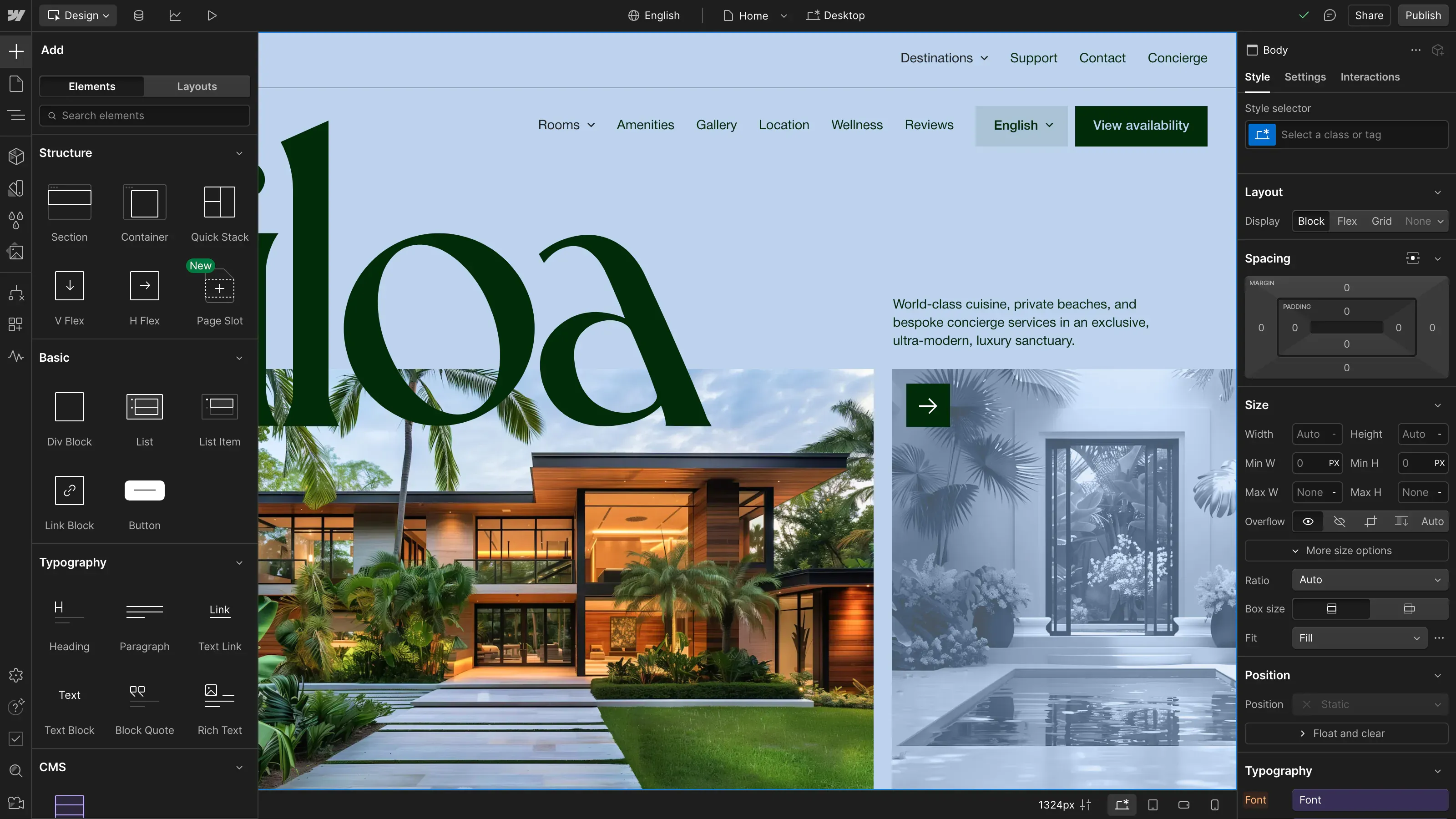
The left sidebar contains:
- The Add tab, with all the elements you can add to your page
- The Navigator tab, showing the hierarchical structure of your page
- The Pages tab, to manage all your pages and templates
- The CMS tab, to define and manage your content collections
- The Ecommerce tab, to configure your online store
- The Symbols tab, to create reusable components
- The Assets tab, to manage your images and other files
The right sidebar includes:
- The Style tab, to control each element’s appearance
- The Settings tab, for selected element parameters
- The Interactions tab, to create animations and interactions
The top bar contains:
- Breakpoint controls for responsive design
- Preview and publish options
- Undo/redo controls
- Export and share options
This comprehensive interface can seem intimidating at first, but it’s logically designed and gives you direct access to all the features you need.
The class system: the power of visual CSS
Webflow’s class system is one of its major strengths. It lets you visually control what would normally be written in CSS.
Classes are at the core of Webflow’s styling system. Instead of applying styles directly to elements (which creates a maintenance nightmare), you create reusable classes:
- Regular classes: Basic styles applied to multiple elements
- Combo classes: Multiple classes applied to the same element
- States: Styles for different states (hover, focus, etc.)
- Global classes: Styles shared across the entire site
This system lets you maintain visual consistency and make global changes by modifying a single class—exactly how professional developers work.

Element hierarchy: the structural foundation
In Webflow, everything is organized with a clear HTML element hierarchy:
- Body: The main container of your page
- Sections: Large horizontal divisions of your page
- Containers: Elements that center and constrain content width
- Grids: Grid layout systems
- Flexboxes: Flexible containers for adaptive layouts
- Divs: Generic blocks for grouping elements
- Standard HTML elements: Paragraphs, headings, images, buttons, etc.
This hierarchy directly reflects a page’s DOM structure, which explains why the generated code is so clean and performant.
The CMS system: dynamic and powerful
Webflow’s CMS consists of several interrelated elements:
- Collections: Define content types (articles, products, etc.)
- Fields: The various data for each collection (title, image, etc.)
- Templates: How each collection item displays
- Collection Lists: How to display multiple collection items
- Filters and sorts: For dynamic content organization
- Relations: To link different collections together
This flexible system allows you to create virtually any content structure, from simplest to most complex.
The interactions editor: code‑free animations
The Webflow interactions editor is divided into two main modes:
- Page interactions: Animations triggered by page events (load, scroll, etc.)
- Element interactions: Animations triggered by actions on specific elements (click, hover, etc.)
For each interaction, you define:
- A trigger (when the animation occurs)
- Actions (what happens)
- Parameters (how it happens: duration, timing, etc.)
This visual interface lets you create animations that would normally require advanced JavaScript, all without writing a line of code.
The E-commerce system: built‑in store
Webflow E‑commerce includes everything you need for an online store:
- Products: Physical, digital, with variants
- Categories: To organize your catalog
- Cart: Fully customizable visually
- Checkout: Optimized transaction process
- Payments: Integrations with Stripe, PayPal, etc.
- Orders: Management and purchase tracking
- Emails: Automated transactional notifications
Every aspect of your shop can be visually customized, setting Webflow E‑commerce apart from many other platforms.
The publishing system: from design to deployment
Webflow streamlines the site deployment process with:
- Environments: Development vs production
- Staging: Preview your changes before publishing
- Versioning: Back up previous versions
- Deployment: One‑click publishing to Webflow servers
- SSL: Automatic SSL certificates
- CDN: Global content delivery network
This system eliminates usual deployment complexities and lets you publish updates instantly and securely.
Need Webflow experts for your project?
You’re convinced by Webflow’s capabilities, but you don’t have time to learn a new platform? Or maybe you need a highly complex site that requires advanced expertise?
Studio Namma is your ideal partner to transform your vision into reality with Webflow.
Our team of certified Webflow designers and developers creates professional sites that stand out for design, performance, and conversion.
Whether you need an elegant showcase site, a high‑performance e‑commerce platform, or a complex CMS system, we design tailor‑made solutions that precisely meet your goals.
Contact Studio Namma today to discuss your project and discover how we can help you leverage Webflow’s full potential.
How Webflow works in practice
Webflow’s interface: intimidating but powerful
First thing to admit: Webflow’s interface can seem intimidating at first glance.
There are many buttons, options, panels. That’s normal. You’re looking at a sports car cockpit, not a kick scooter’s controls.
The interface is divided into several key zones that we detailed in the Anatomy section above.
The learning curve exists, no doubt. But contrary to what some claim, it’s not insurmountable. If you’ve used Photoshop or Figma before, you’ll quickly feel at ease.
And the reward is well worth the initial effort.
Element hierarchy: think in boxes
The secret to mastering Webflow? Understanding how elements are organized.
Everything in Webflow (as in the web in general) works on the principle of containers holding other containers:
- Sections contain Containers
- Containers contain Grids or Flexboxes
- These contain other elements
This Russian‑doll structure is fundamental to building solid, adaptable designs.
Unlike other builders that hide this reality behind simplistic (and limiting) interfaces, Webflow gives you full control over that hierarchy.
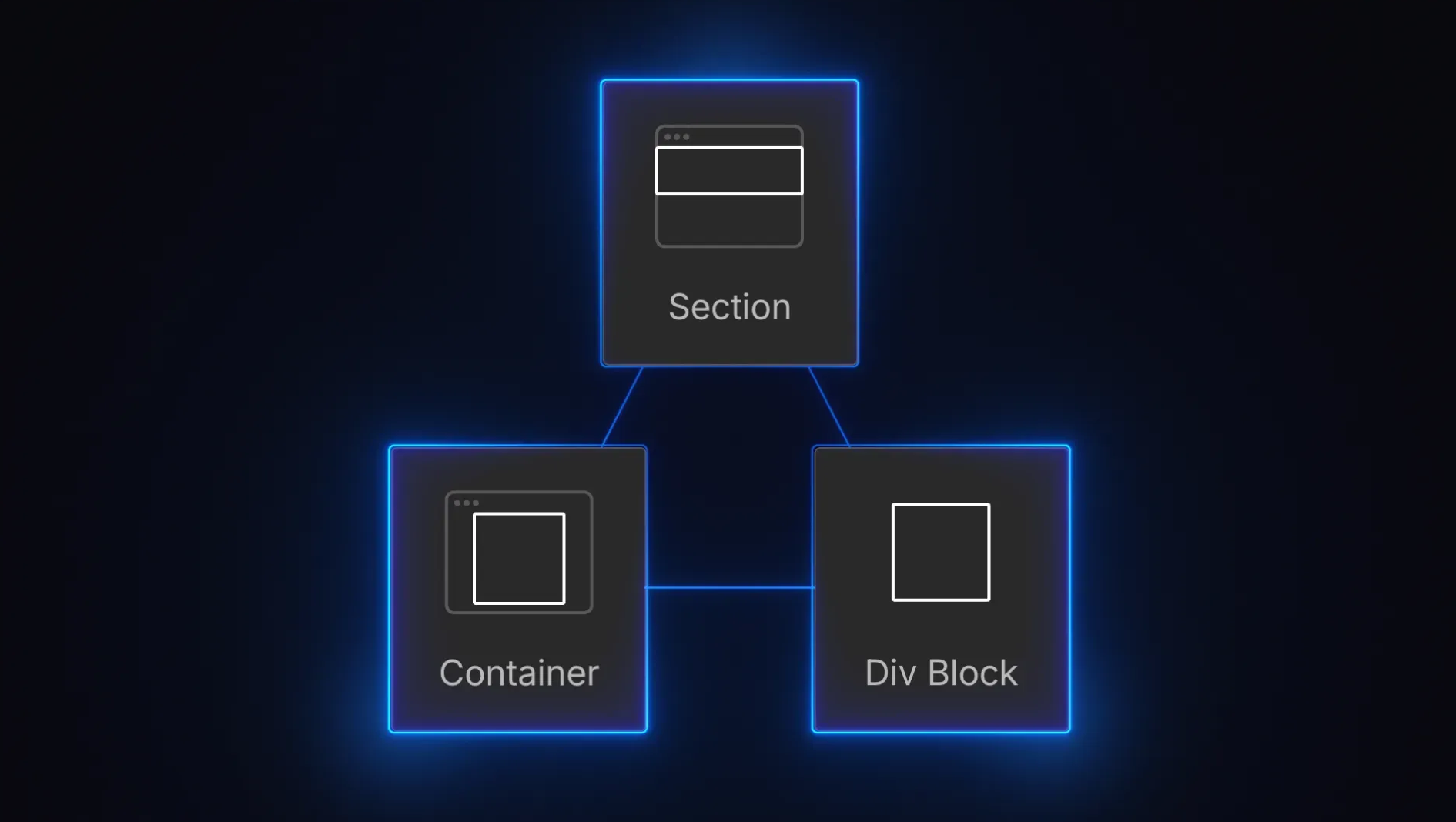
Classes and styles: Webflow’s magic
If you have a CSS allergy, breathe deeply. Webflow revolutionized style management.
Instead of assigning styles directly to elements (creating a maintenance nightmare), Webflow uses a class system inspired by CSS best practices:
Standard classes: Base styles for elements
Combo classes: Reuse common styles
States: Define appearance on hover, click, etc.
Variants: Create alternative versions of the same component
This system lets you:
- Maintain visual consistency across your site
- Make global changes by modifying a single class
- Create reusable components
- Structure your styles professionally
It’s exactly how a front‑end developer would organize CSS, but with an intuitive visual interface.
Webflow’s CMS: structure your content like a pro
Creating collections: the foundation of everything
In Webflow, your content is organized in “Collections”—customizable, flexible content types.
A collection can be anything you want:
- Blog posts
- Products
- Customer testimonials
- Team members
- Events
- Anything else requiring multiple similar entries
For each collection, you define exactly which fields it contains: text, images, numbers, dates, files, relationships with other collections...
It’s like designing your own database, without knowing SQL.
Collection Templates: dynamic power
Once your collections are created, you set how they display via “Collection Templates.”
Think of them as molds that determine each collection entry’s appearance.
For a blog, you create a post template that defines:
- Where the title goes
- How the main image displays
- The content layout
- Metadata display (date, author, categories)
The genius of the system? You design this template visually once, and it automatically applies to all current and future posts.

Collection Lists: list, filter, organize
How to display multiple collection entries? Through “Collection Lists.”
These special pages let you:
- Show your content lists
- Set how many items appear per page
- Create pagination systems
- Add dynamic filters and sorts
- Customize each item’s look
It’s perfect for blogs, product catalogs, directories, or any page displaying multiple similar items.
E‑commerce with Webflow: sell without headaches
If you’ve built an online store before, you know the usual complexity: plugin setup, finicky payment gateways, rigid templates...
Webflow E‑commerce drastically simplifies that process while keeping full design flexibility.
What you can do:
Complete product management : Create physical or digital products with variants and stock tracking.
100% custom design : Unlike most e‑commerce platforms, you control exactly how your products, cart, and checkout appear.
Payment integrations : Stripe, PayPal, Apple Pay, Google Pay… with no extra plugins.
Automated tax handling :Webflow calculates taxes based on your customers’ locations.
Customizable transactional emails : Order confirmations, shipping notifications, etc.
Limits to know:
Let’s be honest: Webflow E‑commerce isn’t universal. A few limitations exist:
- Maximum of 500 products (enough for most stores)
- No native subscription system (though workarounds exist via integrations)
- Limited B2B features
[For a detailed comparison with platforms like Shopify or WooCommerce, check out our dedicated article.]
Integrations & extensions: beyond the basics
Webflow isn’t closed off. It integrates seamlessly into the broader digital ecosystem.
Native integrations and API
Webflow offers direct integrations with many essential services:
- Google Analytics
- Facebook Pixel
- Google Tag Manager
- Google Maps
- And more
For more specific needs, the Webflow API lets you connect almost any external service.
Webflow Apps: an expanding ecosystem
A major recent development: Webflow Apps. This extension platform lets you add advanced features without leaving the Webflow environment:
- Advanced search systems
- CRM integrations
- SEO optimization tools
- Booking systems
- Community features
Though recent, this ecosystem is rapidly growing and significantly expands Webflow’s native potential.
Performance and SEO: Webflow’s hidden strengths
Code that pleases Google
SEO isn’t just about content and backlinks. Technical quality matters.
Webflow excels here:
- Semantic, clean HTML
- Optimized load times
- Excellent Core Web Vitals by default
- Structure aligned to mobile‑first indexing
A Backlinko study showed Webflow sites score 22% higher on average for Core Web Vitals than similar platforms.
Total control over metadata
Webflow gives you granular control over all major SEO elements:
- Customizable titles and meta descriptions per page
- Alt‑text for all images
- Custom URL structure
- Schema.org markup
- 301 redirect management
- Automatically generated sitemaps
Auto‑optimized images
Heavy images are SEO’s enemy.
Webflow solves this automatically:
- Smart image compression
- Adaptive resizing depending on the device
- Modern formats (WebP, AVIF) served to compatible browsers
- Native lazy loading
Result? Faster pages, happier users, and better rankings from Google.
Webflow hosting: fast, secure, but not cheap

Webflow isn’t just a site builder—it’s also a hosting platform.
Hosting advantages
Global CDN : Your site is distributed across a worldwide network of servers for fast load times everywhere.
SSL included :Automatic, free SSL/TLS certificates.
Managed updates and security : No server maintenance required.
Automatic scaling : Your site handles traffic spikes without intervention.
Automatic backups : Your data is regularly backed up.
The cost factor
Let’s be blunt: Webflow hosting isn’t the cheapest out there.
Plans start at $14/month for a basic site, $39/month if you use the CMS, and $79/month for e‑commerce.
That’s more than classic hosts, sure. But you pay for an all‑in‑one service: no separate hosting, security, or updates needed.
For many, that price is justified by the time and headaches saved.
Webflow and AI: intelligence as a creative copilot
In 2025, artificial intelligence has become a real asset integrated into the Webflow ecosystem. It’s not there to replace the designer or developer but to speed up creation, automate repetitive tasks, and open new possibilities without sacrificing creative control.
AI Site Builder
Launched in early 2025, the AI Site Builder can automatically generate a homepage, style guide, and complementary pages from a simple text brief. The tool offers several coherent design variants (typography, colors, layout) that you can then manually tweak in the Designer. A solid base to start a project faster, without starting from scratch.

AI Assistant
Webflow’s AI Assistant, accessible directly in the Designer, eases site creators’ daily tasks:
- Suggests ready‑to‑use sections (testimonials, pricing grids, CTAs, etc.) integrated into your current design
- Auto‑generates text for your pages or CMS collections
- Answers questions in context, referencing official documentation
- Analyzes your site structure and suggests technical or SEO optimizations
This assistant works like a copilot, helping you save time while keeping full control over the outcome.
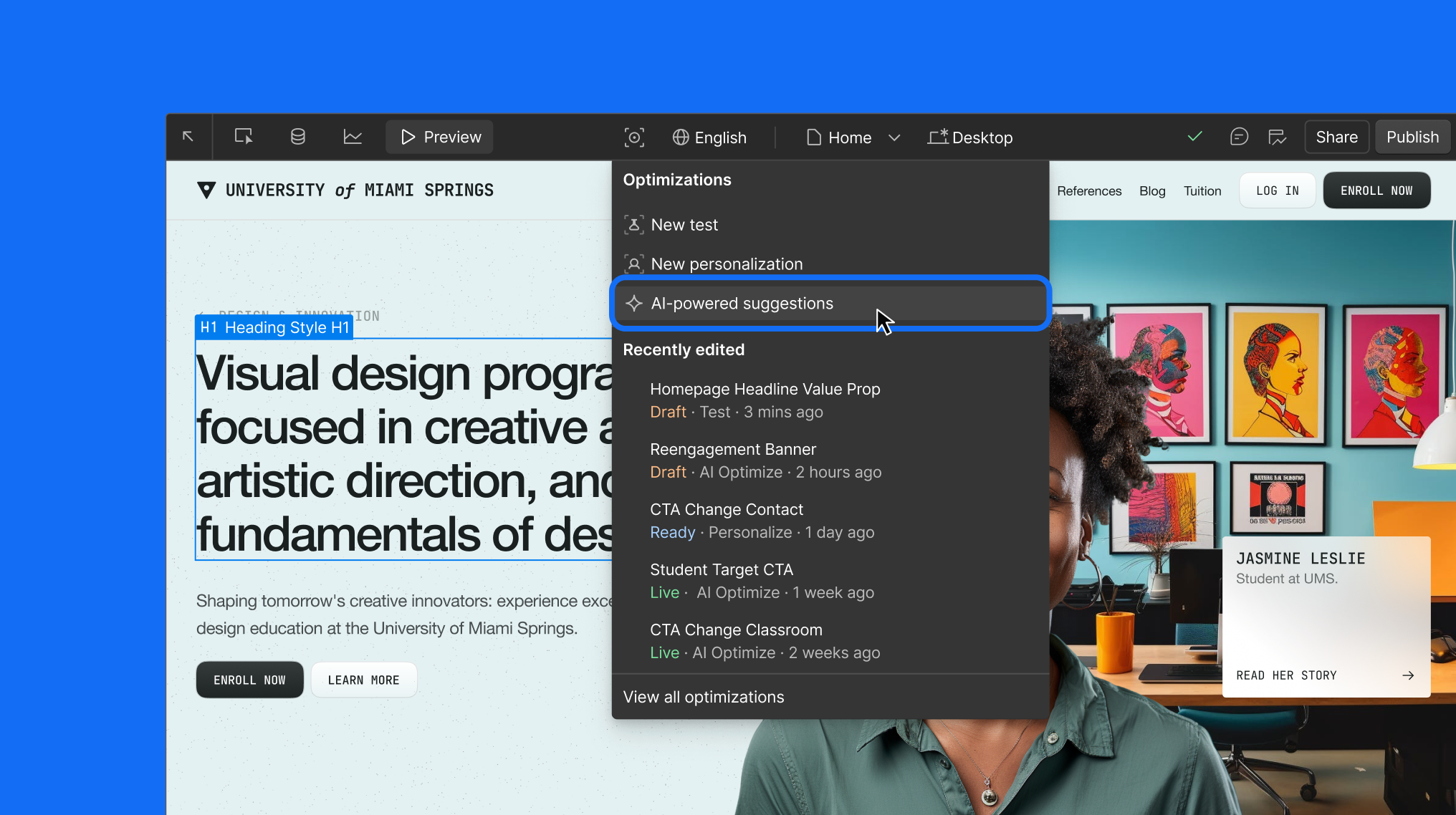
Optimize: AI‑powered A/B testing
With Webflow Optimize, you can now launch A/B tests directly in the Designer. The AI automatically suggests design or content variants (headline, image, button, etc.), which you can activate with one click. Results are measured in real time to optimize conversion effortlessly.

AI Localization & Translation
Multi‑language localization now includes automatic translation via AI. You can easily duplicate your site in multiple languages, optimize each version for local SEO, and manage translations dynamically. A huge time saver for international projects.
Webflow Apps & external AI
The Webflow ecosystem is also enriched by numerous AI apps via the marketplace: image generation, optimized content creation, intelligent chatbots, real‑time personalization, behavioral analysis… These tools integrate natively into your projects and greatly expand possibilities without leaving Webflow.
AI in Webflow doesn’t replace creation—it amplifies it. Whether generating a site from a brief, creating content, optimizing performance, or handling translations, AI becomes a reliable partner to go faster and further—without ever losing control of your design.
Collaborating on Webflow: teamwork made easy
Collaborative workflow
If you work in a team, Webflow offers effective collaboration features:
Access control : Define exactly what each team member can see and edit.
Comment mode : Leave notes directly on site elements.
Version history : Revert to any previous version as needed.
Development environments : Work on your site without affecting the live version.
Publishing approvals : Control what gets published and when.
The content editor: perfect for your clients
One of Webflow’s major strengths is its “Editor” mode—a simplified interface designed for clients or content teams.
This tool allows non‑tech users to:
- Update text and images
- Add new posts or products
- Edit existing content
- Schedule publications
Without ever touching the design or site structure.
It’s the perfect solution for agencies or freelancers who want to give clients autonomy without risking breaking the design.

Webflow trends in 2025
The Webflow world is constantly evolving. Here are the major trends we’re seeing in 2025:
Advanced micro‑interactions and animations
Static sites are long outdated. Users now expect engaging, interactive experiences. Webflow has significantly improved its animation capabilities, allowing sophisticated micro‑interactions once reserved for advanced JavaScript developers.
Scroll‑reactive animations, fluid page transitions, and behavior‑based interactions have become the norm.
Complete design systems
Building complete design systems has become much more accessible with Webflow. Design teams now use:
- Reusable component libraries
- Integrated style guides
- Easily implemented themes and modes (light/dark)
- Component variants for different contexts
This systematic approach ensures visual consistency and faster site evolution.
Native accessibility
Accessibility is no longer an afterthought. Webflow has integrated accessibility tools directly into the Designer:
- Automatic contrast checking
- Keyboard navigation improvement suggestions
- Enhanced screen reader support
- Built‑in accessibility testing
These features help designers build inclusive sites from the start.
Emerging patterns
Several design patterns have gained popularity in the Webflow ecosystem:
- Lightweight 3D interfaces running in‑browser
- Dynamic, responsive typography
- Modular, adaptive grids
- Gesture‑based mobile interfaces
These trends show how Webflow continues pushing boundaries of what’s possible without code.
How much does Webflow really cost?
Let’s talk money. Webflow offers several pricing tiers organized into different categories:
Site plans (for hosting and publishing)
General plans:
- Starter: Free – To explore Webflow (webflow.io domain, 2 pages, 20 CMS collections, 50 CMS items)
- Basic: $14/month – For simple, static sites (custom domain, 150 pages, no CMS)
- CMS: $23/month – For dynamic content sites (150 pages, 20 CMS collections, 2,000 CMS items)
- Business: $39/month – For more complex sites (300 pages, 40 CMS collections, unlimited CMS items)
- Enterprise: Custom pricing – For large organizations with specific needs
E‑commerce plans:
- Standard: $29/month – To start (500 products, 2,000 CMS items, 2% transaction fee)
- Plus: $74/month – For higher volumes (5,000 products, 10,000 CMS items, 0% transaction fee)
- Advanced: $212/month – For large stores (15,000 products, 10,000 CMS items, 0% transaction fee)

Workspace plans (for building and collaborating)
- Starter: Free – To begin (1 full seat, 2 staging sites, 2 agency/freelancer guests)
- Core: $19/month – For extended staging needs (10 staging sites, code export)
- Growth: $49/month – For advanced collaboration (unlimited staging sites, advanced permissions)
- Enterprise: Custom – For large teams
Additional options
- Optimize: From $299/month – For A/B testing and personalization
- Analyze: From $29/month – For advanced analytics
- Localization: From $9/month – For multilingual sites
Professional plans
- Freelancer: $16/month – For freelancers working with a few clients
- Agency: $35/month – For agencies with multiple clients
The structure may seem complex at first glance, but it’s flexible: you can start free to learn, then scale as needed. Prices are based on annual billing—monthly billing is slightly higher.
Is the learning curve an investment or a barrier?
Let’s be honest: Webflow requires a larger initial time investment than ultra‑simplified platforms.
The real cost of “ease”
Platforms that boast “super easy” often hide a hidden cost: severe limitations once you go off script.
Webflow takes the opposite approach:
- A steeper initial learning curve
- But virtually no limits on what you can build
It’s like learning to drive a manual car vs an automatic. A bit harder at first, infinitely more control in the long run.
Excellent learning resources
Fortunately, Webflow offers the best learning resources in the industry:
- Webflow University: free, comprehensive video courses
- Detailed documentation
- Active community on forums and Discord
- Thousands of YouTube tutorials
With these resources, most users reach a satisfactory proficiency level in 2–4 weeks of regular use.
Essential extensions in 2025
The Webflow Apps ecosystem has expanded significantly. Here are some extensions now essential for many projects:
1. Finsweet Client‑First
Client‑First is a methodology by Finsweet to structure Webflow projects in a clear, consistent, maintainable way. It’s based on rigorous naming, logical organization, and shared conventions that facilitate collaboration solo or in teams.
.webp)
A structure built to last
Client‑First enforces a standard architecture on every page:
- page-wrapper: wraps all site content (instead of using <body> directly)
- main-wrapper: holds the page’s main content
- section-[name]: for each identifiable site section
- padding-global: applies consistent side margins
- container-[size]: sets standard max widths (small, medium, large…)
This initial skeleton lets you start every project on solid foundations without reinventing the wheel
A clear naming system
One of Client‑First’s strengths is its naming logic:
- Custom classes (e.g. hero-header, team-card) precisely describe element function
- Utility classes (text-align-center, margin-bottom-medium) are reusable and generic
- Combo classes let you add local variations to a base style without bloating global CSS
Result: you can easily find elements, avoid duplicate styles, and modify design quickly without unintended side effects.
Built for collaboration
Client‑First makes projects readable and maintainable even months later. Solo, agency, or clients revisiting a project will find it predictable. It’s also a time saver for clients who want to edit simple aspects without risking design integrity.
In short: Client‑First isn’t just a naming method, it’s a way to think and build Webflow projects with rigor, efficiency, and clarity. A good practice that has become nearly essential once you aim for scalability.
2. Jetboost
Adds real‑time search and filtering to your Webflow site. Essential for content‑ or product‑heavy sites.
With Jetboost, you can create:
- Dynamic filters for your collections
- Instant search bars
- Favorites and save features
- Advanced sorting systems
This significantly extends the CMS without custom code.
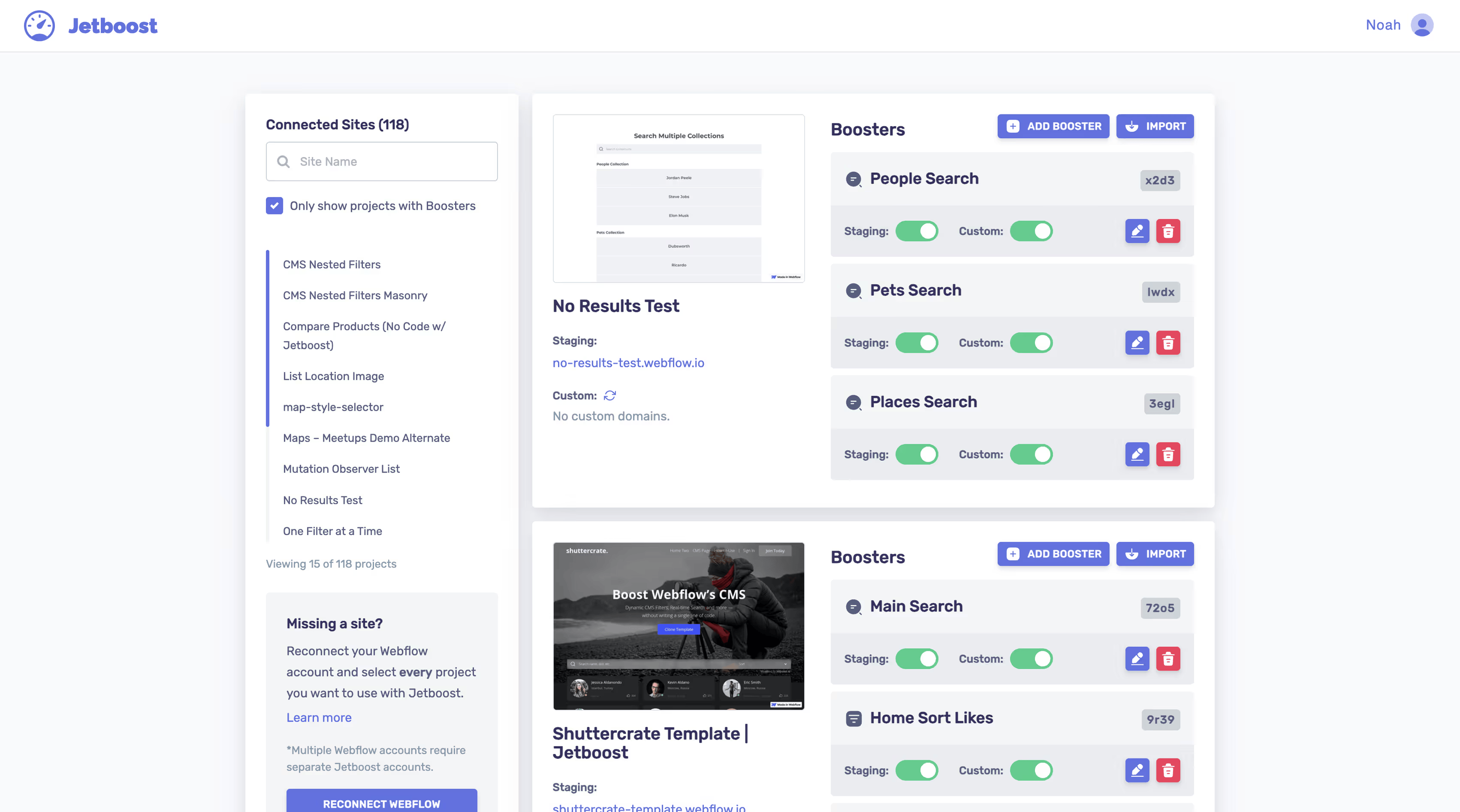
3. Memberstack
Enables membership and restricted access systems on your Webflow site. Ideal for premium content, communities, or online courses.
Memberstack provides:
- User sign‑up and login
- Subscription and payment management
- Granular content access control
- Customizable user profiles
This extension transforms a static Webflow site into a full community or education platform.

4. Relume Library
A library of ready‑to‑use components that greatly speeds up design. Particularly useful for prototyping and rapid launches.
Relume Library offers:
- Hundreds of Webflow‑optimized components
- Complete prebuilt sections
- Style‑consistent variations
- Adaptive, responsive layouts
For designers who want to save time without sacrificing quality, Relume is invaluable.
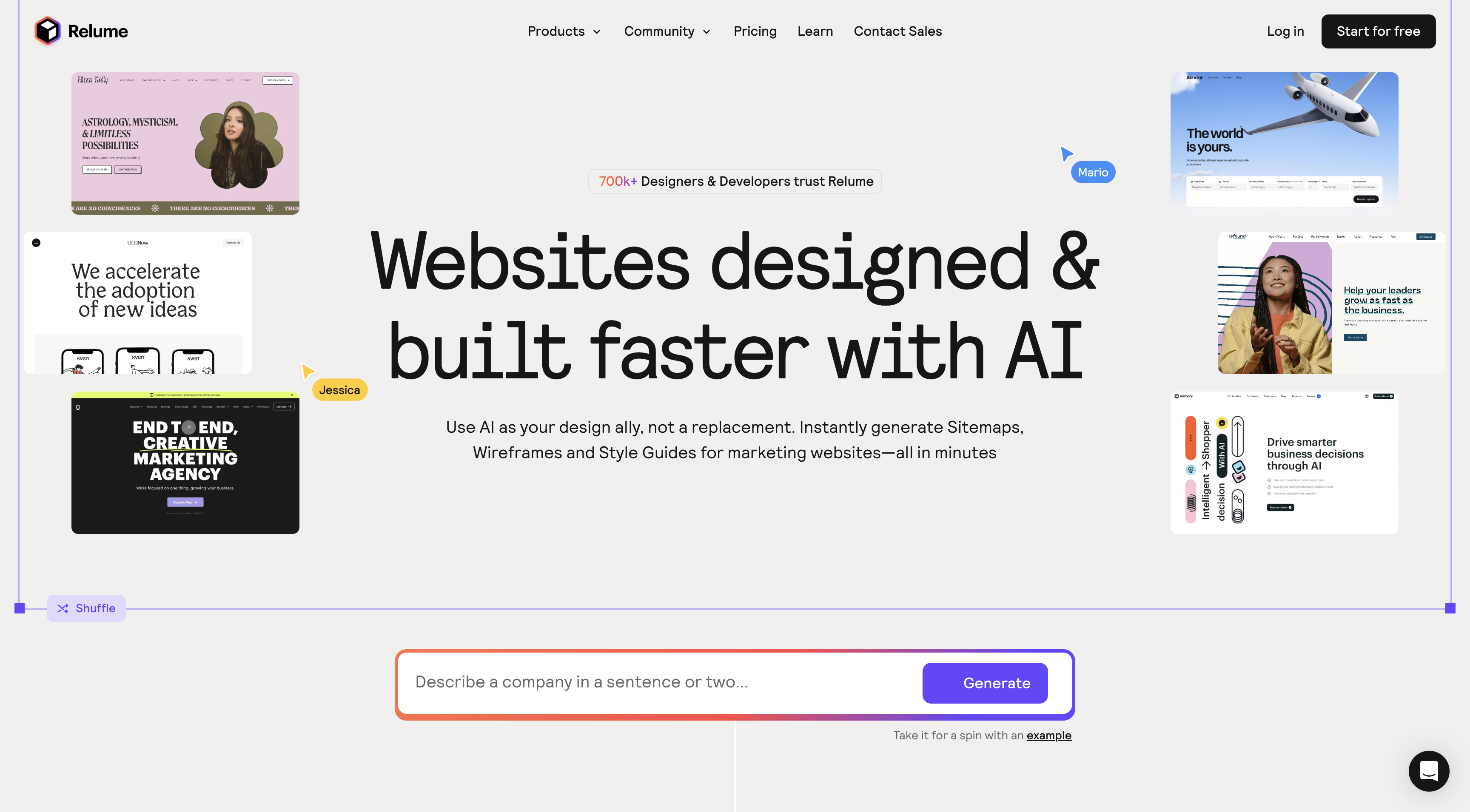
5. GSAP & Webflow: next‑level animation
Webflow already allows complex interactions without code. But to go further, GSAP (GreenSock Animation Platform) is the go‑to library for designers and devs seeking fluid, precise, immersive animations.
GSAP is a powerful JavaScript animation library known for performance and flexibility. It integrates seamlessly with Webflow to extend native editor limits: advanced scroll effects, precise animation sequences, synced micro‑interactions, or full-page transitions.
With GSAP, you gain full control: every detail can be fine‑tuned, timed, and animated smoothly—without performance loss. Many agencies combine GSAP with Webflow for high-end web experiences: fine‑tuned scroll animations, interactive storytelling, dynamic text effects… All perfectly compatible across modern browsers.
If Webflow is your playground, GSAP is the turbo engine. Once mastered, this combo opens the door to a livelier, more engaging, more creative web.
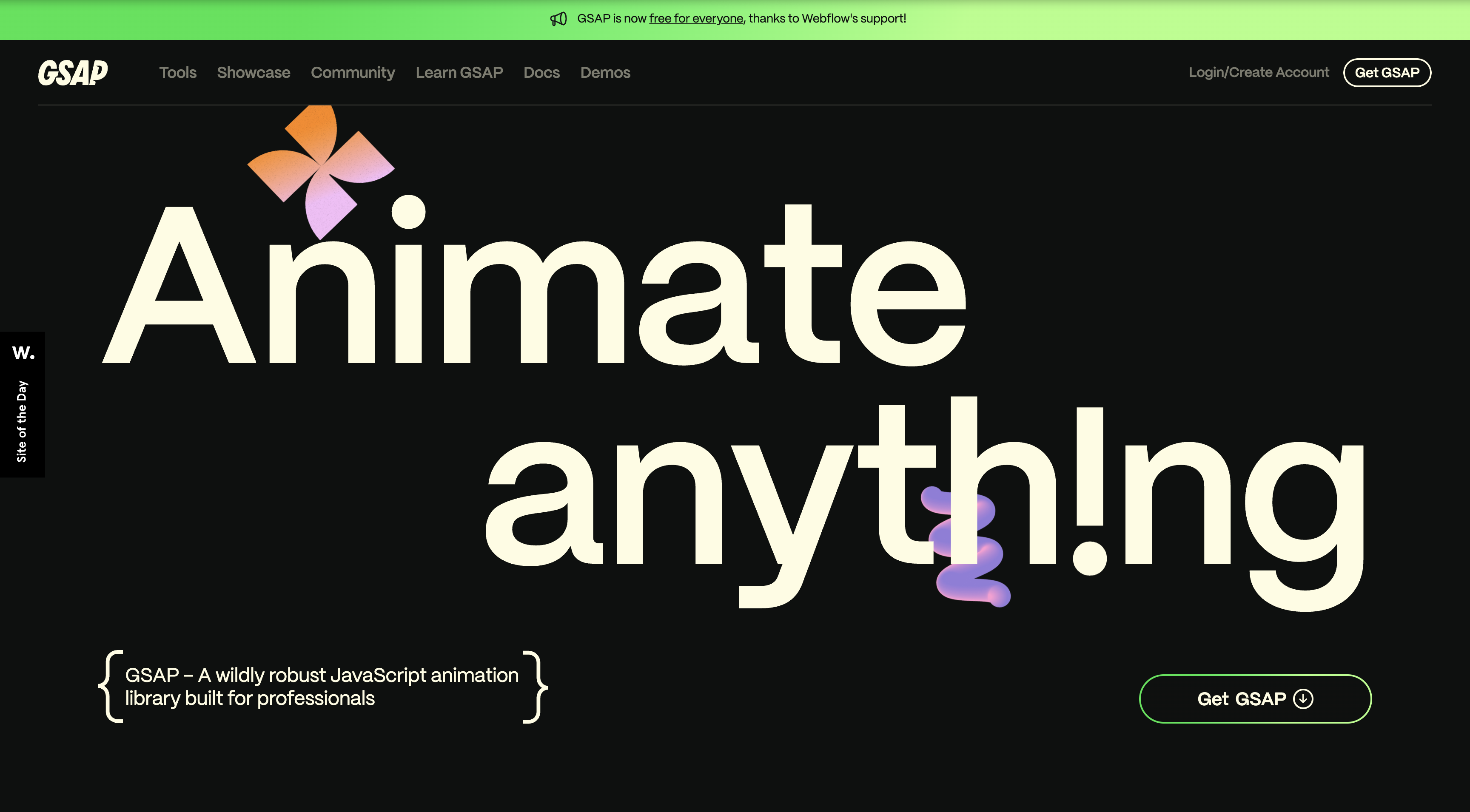
Is Webflow right for you?
Webflow isn’t a miracle solution for every web project. Here’s who should—and shouldn’t—use it:
Webflow is ideal for:
Designers who want to code without coding : If you come from design and want to turn mockups into functional sites without relying on a dev.
Agencies and freelancers seeking efficiency : If you regularly build sites for clients and want a faster workflow without quality compromise.
Businesses that want custom design without custom‑dev price : If you need a brand‑reflective site without the budget for full custom development.
Startups needing rapid iteration : If you have to launch fast and evolve your site as your company grows.
Webflow is probably not for you if:
Your site needs ultra‑specific features : For some niche features, bespoke development remains necessary.
You run a very large e‑commerce store : For shops with more than 500 products and complex needs, specialized platforms may be better.
You’re not willing to invest in learning : If you want a site in 15 minutes with no learning curve, you’ll miss out on Webflow’s strengths.
[For a detailed analysis of scenarios where Webflow is optimal vs when other solutions might be preferable, see our comparison article.]
Migrating to Webflow: is now the right time?
If you’re using another platform now, migration is a key question.
Migration process
Migrating to Webflow generally involves:
- Exporting your content (when possible)
- Recreating your design in Webflow
- Manually or automatically importing content
- Redirecting URLs to preserve SEO
It’s an opportunity to rethink and improve your site, not just replicate it.
The cost of not migrating
You should also consider the cost of staying on a limiting platform:
- Missed opportunities due to tech constraints
- Time wasted on complex workarounds
- Frustration from users facing a subpar site
Sometimes, an initial migration investment can yield significant long‑term returns.
The future of Webflow: where is the platform heading?
Always evolving, Webflow continues adding major features every year.
Current development trends include:
- Enhanced e‑commerce capabilities
- Growth of the Webflow Apps ecosystem
- Advanced authentication and membership tools
- Improved collaboration features
- Deeper integration with AI and automation
Ongoing investment from major venture capital (with valuation exceeding $4 billion) suggests Webflow will keep innovating for years to come.
The Webflow community: an underestimated asset
One of Webflow’s strengths is its vibrant community:
- Highly active official forums
- Dedicated Facebook and Reddit groups
- Meetups in many cities
- Annual Webflow Conference
- Template and resource marketplace
This community accelerates learning and helps you find solutions to nearly any problem.
Webflow templates: development accelerators
If you don’t want to start from scratch, Webflow templates offer an excellent launchpad.
Official marketplace: guaranteed quality
Webflow’s official marketplace offers hundreds of professional templates for all types of projects:
- Business showcase sites
- Creative portfolios
- Blogs and magazines
- E‑commerce stores
These templates are built by Webflow experts and follow best practices for structure, performance, and responsive design.

Clonable free templates
For beginners or budget‑conscious users, Webflow also provides a collection of clonable free templates. These models give a strong foundation and often include interaction examples and CMS structures you can study to enhance your skills.
The Webflow experts ecosystem
Beyond the community, an ecosystem of specialists and agencies has emerged:
- Certified Webflow experts
- Partner agencies (like Studio Namma)
- Trainers and mentors
- Template and extension creators
This external expertise is reassuring for businesses adopting Webflow without building full in‑house capabilities.
Optimizing your Webflow workflow
To make the most of Webflow, here are some best practices that can transform your experience:
Structure before design
Always begin by structuring your site before diving into detailed design:
- Define your sections and containers
- Set a clear hierarchy
- Create a consistent grid system
- Plan your responsive structure
This “skeleton‑first” approach saves you hours of frustration later.
Cohesive naming system
Chaos arrives fast in Webflow if class names aren't well thought out. Finsweet’s Client‑First methodology proposes a clear, readable naming system that aids maintenance and collaboration.
- Descriptive classes for each element (e.g. card‑service, button‑primary, section‑hero): indicates function or position
- Reusable utilities (e.g. margin‑large, text‑center, padding‑section‑medium): manage spacing or formatting without redundancy
- Combo classes: apply local variations to a common base without creating a new global class
This approach boosts project readability in the Designer, minimizes duplication, and makes style management months later much easier.
Use Symbols extensively
Symbols are Webflow’s equivalent of reusable components:
- Create Symbols for recurring elements (nav, footer, cards, etc.)
- Use Symbol variants for different versions
- Update a Symbol to modify all its instances
This modular approach speeds development and simplifies maintenance.
Prepare your CMS ahead of time
Before building collection templates:
- Clearly define your data models
- Identify relationships between collections
- Plan your fields and data types
- Prepare test data
A well‑structured CMS from the outset will save you restructuring time later.
Security and compliance with Webflow
A crucial but often overlooked aspect: security and regulatory compliance.
Platform security
Webflow maintains high security standards:
- Hosting on secure infrastructure (AWS)
- DDoS protection
- Automatic security updates
- Regular backups
You don’t need to worry about common vulnerabilities that affect other platforms.
GDPR compliance and regulations
To ensure compliance on your Webflow site:
- Use built‑in cookie management tools
- Customize consent banners
- Implement clear privacy policies
- Use compliant form integrations
Webflow makes compliance easier, but you’re responsible for ensuring your site meets applicable regulations.
Is Webflow worth the investment in 2025?
If you want to build a professional site without the limitations of simple builders or the complexity of full custom development, Webflow is probably the best compromise available in 2025.
The question isn’t “Can you afford Webflow?” but rather “Can you afford not to use it?”
For serious businesses and professionals, the time saved, creative freedom, and quality gains far outweigh the initial learning and subscription costs.
Webflow has transformed how professional websites are built, democratizing tools once reserved for developers, without sacrificing quality or performance.
In 2025, it has become an industry standard for good reason.
Are you ready to discover what Webflow can do for your project? Contact Studio Namma for personalized support from certified Webflow experts, or start exploring for free to experience this revolutionary platform’s potential yourself.
Work with us if average isn’t your thing.
Drop it, we'll build it!

